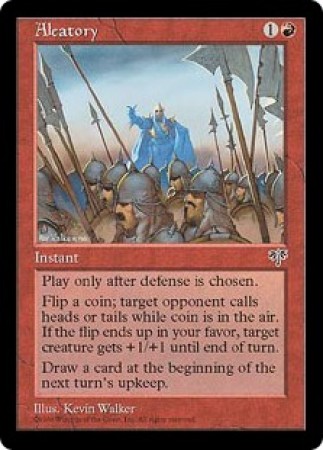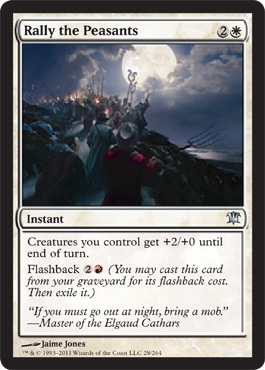1.0 SEQUENCE OF PLAY

1.0 SEQUENCE OF PLAY

| 1.1 Initiative Phase | 1.2 Initial Missile Phase | 1.3 Rally Phase | 1.4 Movement Phase | 1.5 Missile and Magic Phase |
| 1.6 Melee Phase | 1.7 End of Game Round Phase | - | - | BATTLESYSTEM |
The BATTLESYSTEM GAME is played in Game
Rounds. Each Game Round is approximately equal
to
one Melee Round in the AD&D
or D&D games. Each
Game Round consists of seven Phases.
PROCEDURE
Each Game Round follows a set
sequence that allows characters and their
forces to perform any or all of the
actions that go on during an AD&D
or
D&D melee round*. (EXCEPTION: In
the D&D game, everything except
movement takes place at the rate of one
melee round to one Game Round. Use
the D&D movement rate per game turn
instead of per melee round.) A character
that can attack once or cast one spell can
do the same thing in a given Game
Round. A character capable of multiple
actions, whether by skill or magic, can
perform the same number of actions in a
BATTLESYSTEM Game Round.
Each Game Round consists of Phases.
Each player completes, in sequence, each
of the phases outlined below. The player
who is performing actions during a phase
is the Phasing Player. When all phases
are complete, the players proceed to the
next Game Round. They repeat this
process until the game ends.
You should keep a record of the
passage of Game Rounds. For example, if
the elven cavalry is due to arrive on the
5th Game Round, you must mark off
each Game Round to know when the
elves arrive. If a spell that lasts more
than one Game Round is used, you must
note when a spell was cast and how long
it will last to know when its effects cease.
The rules often refer to actions that
occur during a "friendly" or "enemy"
phase. A "friendly" phase is one in which
you are acting; and "enemy" phase occurs
when your opponent is acting.
* A BATTLESYSTEM Game Round is
actually much longer than either an
AD&D or D&D game melee round.
However, the scale of a large battle is
such that the conversion of one Game
Round to one melee round in terms of
the number of actions that can take place
is reasonably accurate. Note that
individual combat ([9.4]) is handled at a
rate of 3 melee rounds per
BATTLESYSTEM Game Round.
SEQUENCE OF PLAY
[1.1] INITIATIVE PHASE
Each side rolls 1d6 (reroll all ties). The
winning side is considered Side A for the
Game Round, the loser is Side B.
If there is more than one player on a
side, but all the forces on a side are
allied, the players on that side determine
the order in which they will act within
each phase of the Game Round. If there
are more than two sides in a particular
battle, you must add a "Side C" (or even
more) to each phase.
Side A takes any initial missile fire to
which it is entitled (and removes killed
figures); Side B does the same after Side
A has fired.
[1.3] RALLY PHASE

Side A attempts to rally any mobs or
routed forces; Side B does the same.
Side A chooses which side moves its
forces first. The first side moves any or
all of its forces that are eligible to move.
The second side then takes any
pass-through fire ([10.6]) to which it is
entitled. Then, the second side moves
and the first side takes pass-through fire.
This phase consists of several steps,
which must be followed in order.
A. Magic
Side A uses any remaining eligible magic.
Side B repeats.
B. Missile Fire
Side A fires any remaining eligible missiles.
Side B repeats.
C. Artillery
Side A fires artillery weapons.
Side B repeats.
Units in base-to-base contact resolve melee combat in the following order:
A. Individual Combat
Individuals (1-1 ratio) figures
in base-to-base contact conduct melee
according to normal AD&D or D&D
game rules.
For such combat only, three AD&D
or D&D game melee rounds are fought in each BATTLESYSTEM
Game Round.
Only the individuals in combat can be affected by any attacks used
in individual combat.
B. Unit Combat
Side A chooses the order in which all
other melee combat will be resolved. All
combat involving one unit or opponent
must be resolved before moving to the
next combat. In each combat, Side A
attacks first, followed by Side B.
Side A or the referee records the end of
the Game Round, and the sequence
begins again with determination of
initiative.
Q: When is a melee
round finished?
Do units that come into
contact simply
fight until one of them
routs or
is annihilated?
A: A melee (game)
round is over when each
side has made one attack
(remember that
melee attacks are assumed
to take place
simultaneously). If there
are still figures in
base-to-base contact after
this, move on
the next phase of that BATTLESYSTEM
supplement Game Turn. A
battle is finished
when one side is either
destroyed,
routs, withdraws, or is
otherwise rendered
incapable of continuing
the fight.
(127.67)
![]()
Reduce - Reuse - Recycle